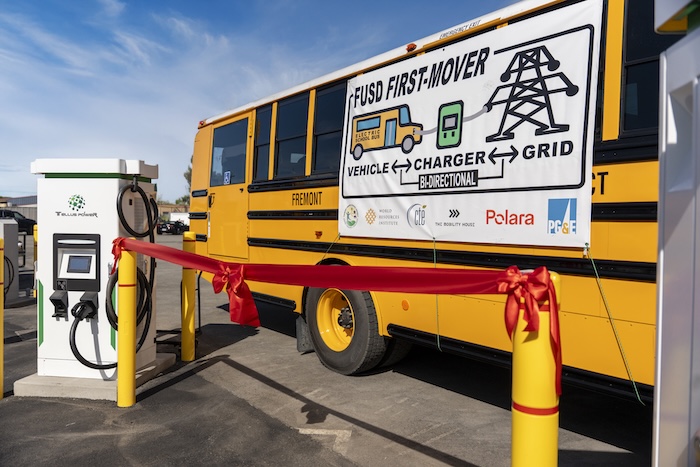The Mobility House Energizes V2G Charging System for Fremont Unified School District’s Electric School Bus Fleet
District and school administrators hosted a ceremony on August 7th to celebrate the successful implementation of their new vehicle-to-grid (V2G) charging system at the Fremont Unified School District (FUSD) Transportation Yard. The event was co-presented by The Mobility House, and included project partners World Resources Institute, Center for Transportation and the Environment, and Polara.

“Electric school buses, with their large batteries and predictable schedules, have tremendous potential to support the electric grid with V2G,” said Gregor Hintler, CEO North America of The Mobility House. “We are proud to provide the technology that enables the district to drive clean and support community energy resilience.”
The commissioning represented phase one of a two-phase project which will include six bidirectional chargers, enabled for V2G participation in demand response with Pacific Gas & Electric’s (PG&E) Emergency Load Reduction Program (ELRP) by The Mobility House’s ChargePilot® charge management system for fleets and utility-facing market aggregation platform.
“This project is a shining example of how innovation creates a cleaner, smarter energy future,” said Mike Delaney, Vice President, Utility Partnership and Innovation, PG&E. “We’re proud to support Fremont USD and school districts across California as they convert to better, electrified student transportation.”
Here’s how it works:
- ChargePilot manages daily smart charging of the buses, controlled and monitored by the fleet operator in an intuitive online dashboard.
- The market aggregation platform receives notifications from PG&E of an upcoming load reduction event via OpenADR, and suggests optimal charging schedules based on the event and time-of-use electricity prices.
- ChargePilot adjusts charging optimization for the bus fleet to discharge power to reduce site load during the emergency event, while continuing to ensure vehicle readiness for departure on their next route.
- By participating in ELRP, the fleet can greatly offset charging costs, making operations more efficient and cost-effective.
The Mobility House continuously develops its technical capabilities and programs to coordinate with utility programs for fleet vehicle-grid-integration and V2G in California and beyond, including demand response programs and dynamic rates available in other states including Massachusetts and New York.
“We’ve already seen how the electric buses can contribute to cleaner air for our community,” said Ernest Epley, FUSD’s Director of Transportation. “Now, we have the opportunity to use these buses to deliver clean and reliable energy too.”
The V2G infrastructure project was funded by a grant from the California Energy Commission’s Clean Transportation Program.
The Mobility House | https://www.mobilityhouse.com/usa_en/
California Energy Commission | https://www.energy.ca.gov








